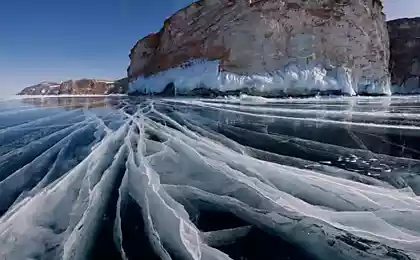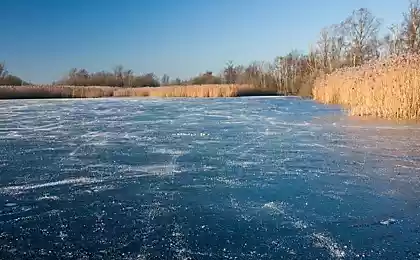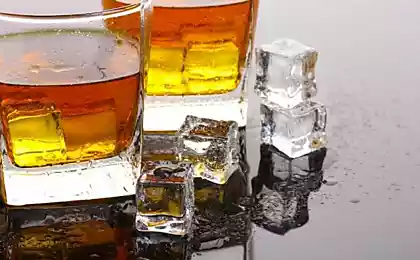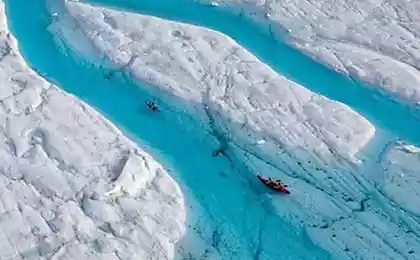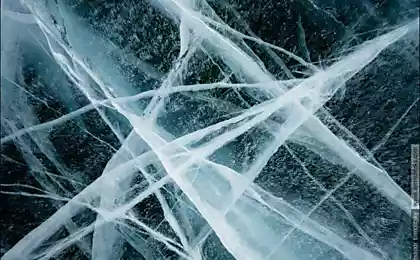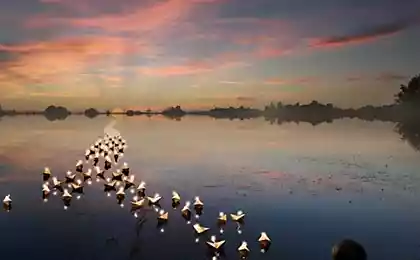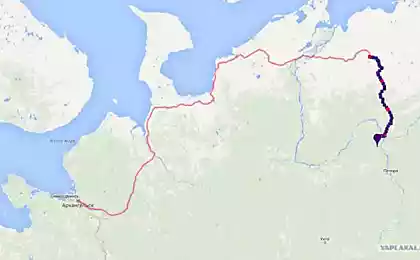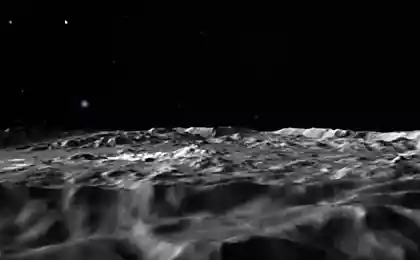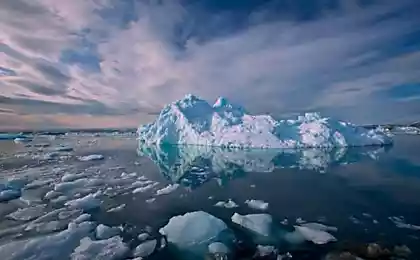1526
Ledyanyhe wonders of nature
Many of these natural wonders is possible to see only the scientists, as they are in the cold, sparsely populated areas of the planet.
This Blue River - a paradise for lovers of kayaking in Greenland. Melting glaciers Petermann fills the low-lying area perfectly clear blue water. This phenomenon occurs seasonally, causing the river to change its shape. Bright blue glacial water is unique to these regions.

Ice waterfalls
Svalbard, which means "cold coast", is an archipelago in the Arctic, constituting the northernmost part of Norway and Europe. This place is located about 650 kilometers north of mainland Europe, midway between mainland Norway and the North Pole. Despite being so close to the North Pole, Svalbard is relatively warm due to the heating effect of the Gulf Stream, which makes it suitable for housing. In fact, Svalbard - the northernmost permanently inhabited area on the planet. The islands of Svalbard cover a total area of 62, 050 square meters. km, almost 60% of which are covered with glaciers, many of which go directly into the sea. Giant glacier Brosvellbrin, located on Nordaustlandet - the second largest island in the archipelago, is stretched by as much as 200 kilometers. 20-meter ice edge of the glacier crossed by hundreds of waterfalls. These waterfalls can be seen only in the warmer months.
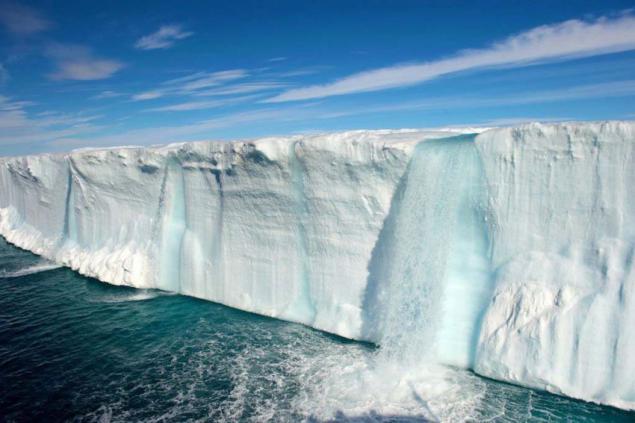
Crystal Caves
This cave in the glacier - the result of glacial melting, when the rain and melt water on the surface of the glacier are directed into streams that are part of the glacier through cracks. The flow of water gradually melts a hole, performing the way to the lower areas, forming long crystal cave. Fine sediments in the water along the flow of meltwater give a dirty color, while the top of the cave is shown in dark blue. Due to the rapid movement of the glacier, approximately 1 m per day on uneven terrain, the ice cave is transformed into its end in a deep vertical slit. This allows natural light to enter the ice cave at both ends. The cave is accessible through a 7-meter entrance to the shoreline. In the end, it tapers to a narrow passage difficult, not more than a meter tall. Ice caves are located in unstable areas and can collapse at any time. They are safe to enter only in the winter, when cold temperatures reinforce the ice. Despite this, you can hear the constant sound of grinding ice in a cave. This is not because everything is going to collapse, but because the cave is moved along with the glacier itself. Every time a glacier moved a millimeter, you can hear very loud sounds. Attractions Iceland caves are very popular.
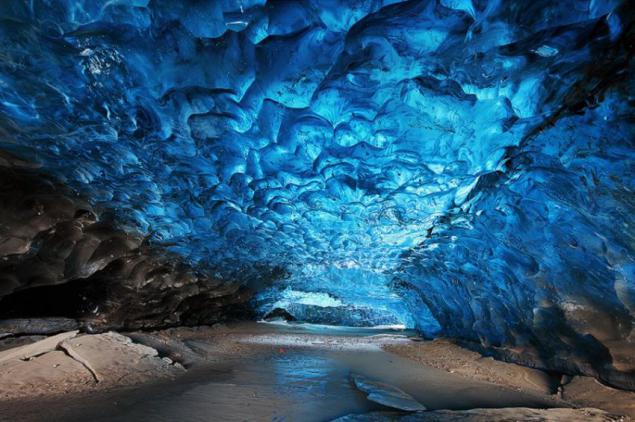
Glacier Briksdal
Briksdalsbrin or Briksdal Glacier - one of the most accessible and best known arms of the glacier Yostedalsbrin. This place is situated in Norway, and is part of the National Park Yostedalsbrin. Glacier terminates in a small glacial lake, which is 346 meters above sea level. Visitors from all over the world come to see the beautiful outlet glacier Briksdal, beautifully situated among waterfalls and high peaks. With the proper equipment and experienced guides, visitors can enjoy a completely safe, but incredibly exciting tour.
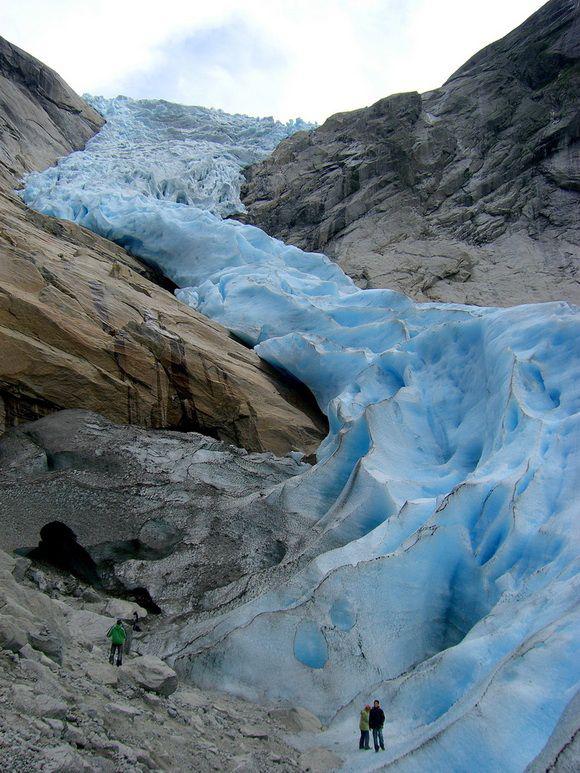
Canyon Bearsden
Bearsden canyon carved by melt water is 45 meters deep. This photo was taken in 2008. Along the edge of the Greenland Ice Canyon, a line on the wall shows the stratigraphic layers of ice and snow, established over the years. Black layer at the base of the channel is a cosmic dust - swollen powder dust which is deposited and deposited on snow, glaciers and ice sheets.

Elephant Foot Glacier
Arctic Glacier foot elephant found in northern Greenland. The gray zone at low elevation is engraved on the glacier meltwater channels, clearly separated from the white surface accumulation zone higher. It is easy to understand from where this came the name of the glacier. This unique glacier is located in a wonderful geographic position in the north-east coast of Greenland.

Frozen Wave
This unique wave is frozen in Antarctica. She was discovered by an American scientist Tony Trevouillonom in 2007. These pictures do not really show a giant wave, somehow frozen in the process. Formation contains a blue ice, and it is - strong evidence that it was not created instantly from the waves. Blue ice is created by compressing the trapped air bubbles. Ice looks blue because, when light passes through the layers, the blue light is reflected back, and red light is absorbed. Thus, a dark blue color suggests that ice formed slowly over time, rather than instantaneously. Subsequent thawing and refreeze for many seasons gave the formation of a smooth, wave-like appearance.

Striped iceberg
In most icebergs are blue and green stripes, but may be brown. This phenomenon often occurs in the Southern Ocean. Striped Icebergs with multiple colored stripes, including yellow, brown, fairly common in the cold waters of Antarctica. Colored icebergs are formed when large pieces of ice break away from the ice shelf and fall into the sea. Because glaciers are composed of snow falling on Antarctica for many thousands of years, ice made from fresh water. Thus it appears that floating fresh ice interacts with the salt water. Sea water is in contact with supercooled glacier and frozen as if covering its crust. This top layer of ice formed from sea water contains organic matter and minerals. Caught up in the waves and blown by the wind, icebergs can be painted with amazing colored stripes of different forms and structures. Iceberg appears white because of the tiny bubbles trapped in the ice and scattered light. Blue areas are created when a crack in the ice sheet is filled with melt water, which quickly freezes. In this case, the bubbles do not have time to form. When the water is rich in seaweed, the band can be painted in green, and in a different shade.

Icy Tower
Hundreds of ice towers can be seen on top of the volcano Mount Erebus (3,800 m). They look like a one-day stubble on his face giant. Constantly active volcano, perhaps the only place in Antarctica, where fire and ice meet, mingle and create something unique. Towers can reach 20 meters high and look almost alive, releasing jets of steam to the southern polar heavens. Part of volcanic vapor freezes, putting the inside of the tower, expanding and extending them.
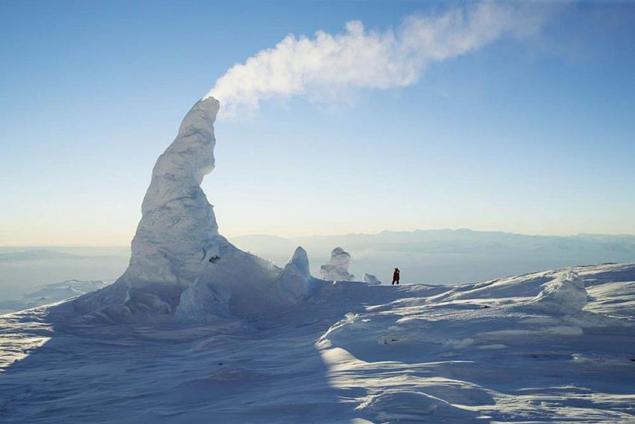
Frozen waterfall
Fang - Waterfall, located near the town of Vail in Colorado. A huge pillar of ice is formed from this waterfall is only at extremely cold winters, when the frost creates an ice column, grows up to 50 meters in height. Frozen waterfall Fang has a foundation, up to 8 meters in width.

Penitentes
Penitentes - amazing ice spikes, formed naturally in the plains in the high-altitude areas of the Andes range, at an altitude of over 4,000 meters above sea level. These ice spikes reach of varying heights from a few centimeters up to 5 meters, giving the impression of an ice forest. The tips of their blades always point to the sun. they slowly begin to take shape, when the ice melts from the early sunlight. The people of the Andes have attributed this phenomenon is faster than the wind in the area, which is in fact the only part of the process. According to recent scientific observations of sunlight that falls on the ice, heats it, moreover, some of the light is trapped in the ice, which leads to unequal melting ice and those parts of ice, which does not pose is formed statue strange shape known as Penitentes.
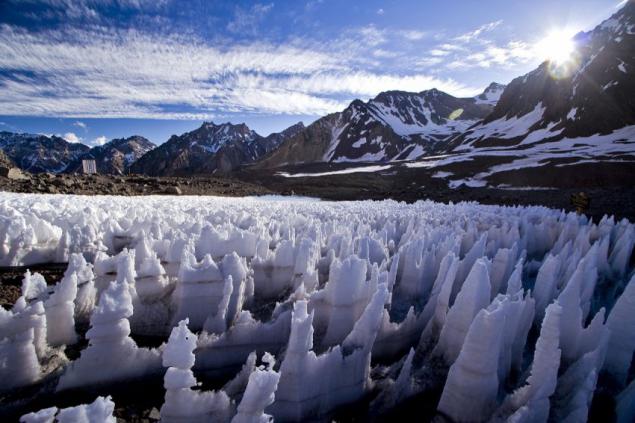
Kungur Ice Cave, Russia
Kungur Ice Cave - one of the largest caves in the world and the most amazing wonders of the Urals, which is located on the outskirts of Kungur in Perm region. It is believed that the cave for more than 10 thousand years.
Its total length is 5700 meters inside the cave 48 caves and 70 underground lakes with a depth up to 2 meters. The temperature inside the ice cave ranges from -10 to -2 degrees Celsius.

Source: www.infoniac.ru
This Blue River - a paradise for lovers of kayaking in Greenland. Melting glaciers Petermann fills the low-lying area perfectly clear blue water. This phenomenon occurs seasonally, causing the river to change its shape. Bright blue glacial water is unique to these regions.

Ice waterfalls
Svalbard, which means "cold coast", is an archipelago in the Arctic, constituting the northernmost part of Norway and Europe. This place is located about 650 kilometers north of mainland Europe, midway between mainland Norway and the North Pole. Despite being so close to the North Pole, Svalbard is relatively warm due to the heating effect of the Gulf Stream, which makes it suitable for housing. In fact, Svalbard - the northernmost permanently inhabited area on the planet. The islands of Svalbard cover a total area of 62, 050 square meters. km, almost 60% of which are covered with glaciers, many of which go directly into the sea. Giant glacier Brosvellbrin, located on Nordaustlandet - the second largest island in the archipelago, is stretched by as much as 200 kilometers. 20-meter ice edge of the glacier crossed by hundreds of waterfalls. These waterfalls can be seen only in the warmer months.

Crystal Caves
This cave in the glacier - the result of glacial melting, when the rain and melt water on the surface of the glacier are directed into streams that are part of the glacier through cracks. The flow of water gradually melts a hole, performing the way to the lower areas, forming long crystal cave. Fine sediments in the water along the flow of meltwater give a dirty color, while the top of the cave is shown in dark blue. Due to the rapid movement of the glacier, approximately 1 m per day on uneven terrain, the ice cave is transformed into its end in a deep vertical slit. This allows natural light to enter the ice cave at both ends. The cave is accessible through a 7-meter entrance to the shoreline. In the end, it tapers to a narrow passage difficult, not more than a meter tall. Ice caves are located in unstable areas and can collapse at any time. They are safe to enter only in the winter, when cold temperatures reinforce the ice. Despite this, you can hear the constant sound of grinding ice in a cave. This is not because everything is going to collapse, but because the cave is moved along with the glacier itself. Every time a glacier moved a millimeter, you can hear very loud sounds. Attractions Iceland caves are very popular.

Glacier Briksdal
Briksdalsbrin or Briksdal Glacier - one of the most accessible and best known arms of the glacier Yostedalsbrin. This place is situated in Norway, and is part of the National Park Yostedalsbrin. Glacier terminates in a small glacial lake, which is 346 meters above sea level. Visitors from all over the world come to see the beautiful outlet glacier Briksdal, beautifully situated among waterfalls and high peaks. With the proper equipment and experienced guides, visitors can enjoy a completely safe, but incredibly exciting tour.

Canyon Bearsden
Bearsden canyon carved by melt water is 45 meters deep. This photo was taken in 2008. Along the edge of the Greenland Ice Canyon, a line on the wall shows the stratigraphic layers of ice and snow, established over the years. Black layer at the base of the channel is a cosmic dust - swollen powder dust which is deposited and deposited on snow, glaciers and ice sheets.

Elephant Foot Glacier
Arctic Glacier foot elephant found in northern Greenland. The gray zone at low elevation is engraved on the glacier meltwater channels, clearly separated from the white surface accumulation zone higher. It is easy to understand from where this came the name of the glacier. This unique glacier is located in a wonderful geographic position in the north-east coast of Greenland.

Frozen Wave
This unique wave is frozen in Antarctica. She was discovered by an American scientist Tony Trevouillonom in 2007. These pictures do not really show a giant wave, somehow frozen in the process. Formation contains a blue ice, and it is - strong evidence that it was not created instantly from the waves. Blue ice is created by compressing the trapped air bubbles. Ice looks blue because, when light passes through the layers, the blue light is reflected back, and red light is absorbed. Thus, a dark blue color suggests that ice formed slowly over time, rather than instantaneously. Subsequent thawing and refreeze for many seasons gave the formation of a smooth, wave-like appearance.

Striped iceberg
In most icebergs are blue and green stripes, but may be brown. This phenomenon often occurs in the Southern Ocean. Striped Icebergs with multiple colored stripes, including yellow, brown, fairly common in the cold waters of Antarctica. Colored icebergs are formed when large pieces of ice break away from the ice shelf and fall into the sea. Because glaciers are composed of snow falling on Antarctica for many thousands of years, ice made from fresh water. Thus it appears that floating fresh ice interacts with the salt water. Sea water is in contact with supercooled glacier and frozen as if covering its crust. This top layer of ice formed from sea water contains organic matter and minerals. Caught up in the waves and blown by the wind, icebergs can be painted with amazing colored stripes of different forms and structures. Iceberg appears white because of the tiny bubbles trapped in the ice and scattered light. Blue areas are created when a crack in the ice sheet is filled with melt water, which quickly freezes. In this case, the bubbles do not have time to form. When the water is rich in seaweed, the band can be painted in green, and in a different shade.

Icy Tower
Hundreds of ice towers can be seen on top of the volcano Mount Erebus (3,800 m). They look like a one-day stubble on his face giant. Constantly active volcano, perhaps the only place in Antarctica, where fire and ice meet, mingle and create something unique. Towers can reach 20 meters high and look almost alive, releasing jets of steam to the southern polar heavens. Part of volcanic vapor freezes, putting the inside of the tower, expanding and extending them.

Frozen waterfall
Fang - Waterfall, located near the town of Vail in Colorado. A huge pillar of ice is formed from this waterfall is only at extremely cold winters, when the frost creates an ice column, grows up to 50 meters in height. Frozen waterfall Fang has a foundation, up to 8 meters in width.

Penitentes
Penitentes - amazing ice spikes, formed naturally in the plains in the high-altitude areas of the Andes range, at an altitude of over 4,000 meters above sea level. These ice spikes reach of varying heights from a few centimeters up to 5 meters, giving the impression of an ice forest. The tips of their blades always point to the sun. they slowly begin to take shape, when the ice melts from the early sunlight. The people of the Andes have attributed this phenomenon is faster than the wind in the area, which is in fact the only part of the process. According to recent scientific observations of sunlight that falls on the ice, heats it, moreover, some of the light is trapped in the ice, which leads to unequal melting ice and those parts of ice, which does not pose is formed statue strange shape known as Penitentes.

Kungur Ice Cave, Russia
Kungur Ice Cave - one of the largest caves in the world and the most amazing wonders of the Urals, which is located on the outskirts of Kungur in Perm region. It is believed that the cave for more than 10 thousand years.
Its total length is 5700 meters inside the cave 48 caves and 70 underground lakes with a depth up to 2 meters. The temperature inside the ice cave ranges from -10 to -2 degrees Celsius.

Source: www.infoniac.ru
